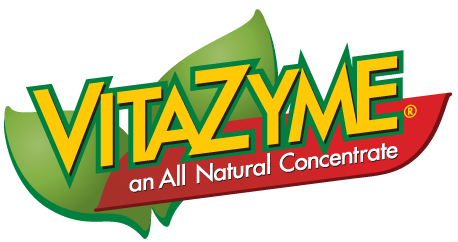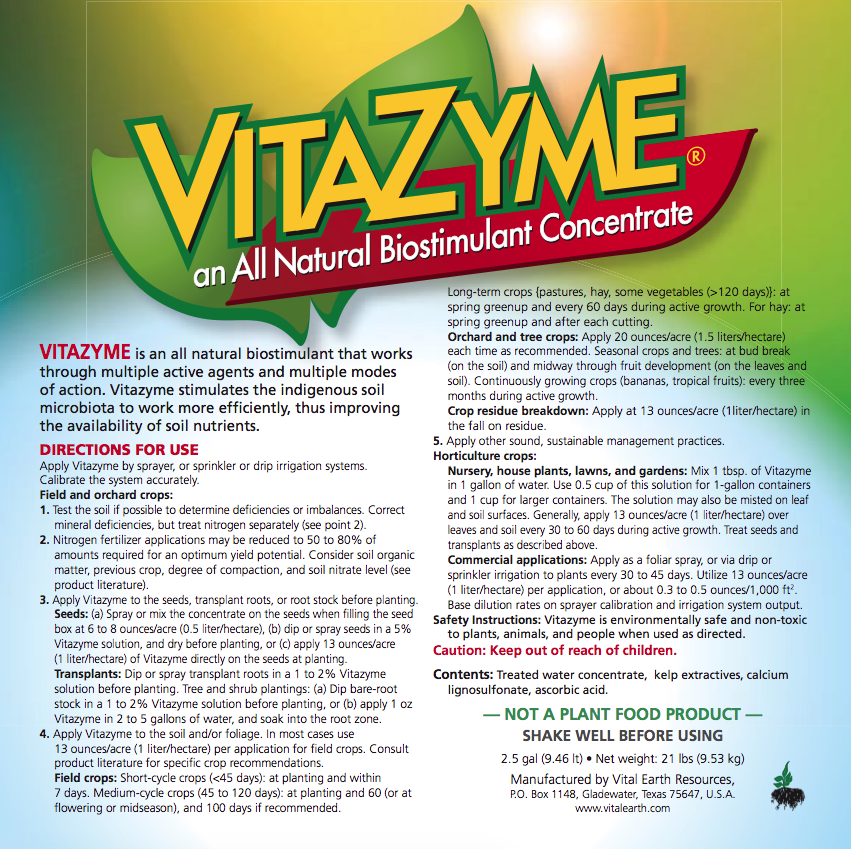
Vitazyme is an all-natural, organic liquid biostimulant for plants and soil organisms. It contains several biological activators. When this product is applied to crops, it improves crop quality, and increases crop yield and resistance to drought, disease, frost and other stresses. It enhances plant health, by stimulating plant-microbial symbiosis and the growth of a beneficial microbial population, and improves soil structure, with repeated use.
The active agents in Vitazyme include enzymes, vitamins, and other powerful, but gentle, growth stimulators such as triacontanol, brassinosteroids, B-vitamins, glycosides, and porphyrins.
Made in the USA.
How Vitazyme Works
As a plant grows in soil, it develops an intimate relationship between the roots and the organisms populating the root zone. The root surface — the Rhizosphere — is teeming with billions of fungi, bacteria, algae, cyanobacteria, protozoa, and other organisms. Because the roots feed the organisms with dead root epidermal cells as well as compounds exuded from the roots themselves, the microbial population of this area is more plentiful than the bulk of the soil. To feed these organisms, the plant may inject up to 25% or more of its energy, which is produced in the leaves as amino acids, carbohydrates, and other compounds.
This happens for a good reason: by feeding the organisms in the rhizosphere, the microbes in turn release soil minerals and secrete organic acids, antibiotics, enzymes, growth regulators, hormones, and other substances which are absorbed by the roots and then transported to the leaves. This symbiotic relationship is enhanced through the use of Vitazyme, which contains “metabolic triggers” which stimulate the plant to photosynthesize better. This enables the plant to fix more sunlight energy in the form of carbon compounds and to increase the transfer of proteins, carbohydrates, and other growth substances into the root zone.
The active agents in Vitazyme may enter the plant through either the leaves or roots with equal effectiveness. This enhances both root growth and root exudation. In turn, the metabolism of the rhizosphere organisms is activated, which triggers a greater synthesis of growth-benefiting compounds and a faster release of minerals for plant uptake, which further stimulates the plant microbial symbiosis.
How to Use Vitazyme
Vitazyme is designed to be used as a supplement to a complete crop management system, never by itself. It reduces costs and increases productivity by enabling your plants to utilize soil fertility and water more efficiently. Soil moisture is needed to activate Vitazyme.
- Vitazyme may be tank-mixed with pesticides and fertilizers
- Vitazyme does not need to be tilled into soil after application
- As long as the proper application rate is used, the dilution rate is not critical
HELPFUL TIP:
It is important to integrate other sustainable, sound management practices into your total program. This includes minimum tillage, soil conservation, crop rotations with legumes, and using proper varieties.
General Applications (for Applications in Specific Crops see the Vitazyme User’s Guide)
- Most Frequent Applications in Growing Crops – Spray on leaves and soil, 1 to 4 times (according to crops), at 3 to 12 weeks intervals, with rates 13 – 16 oz. per acre (1 – 1.2 liters per hectare).
- Direct Seed Row Applications – Dilute 1 part of Vitazyme in 99-199 parts of water (a 0.5 – 1% solution) and spray at 13 oz./acre (1 liter per hectare) onto seeds in row, prior to covering.
- Seed treatment before planting – Treat the seeds with a dilute Vitazyme solution, as 250 ml or cc of Vitazyme for seeds of one hectare (3.3 oz. for seeds of one acre), plus the minimum water for good seed coverage. The seeds and solution can be mixed thoroughly, on planting or last day, in a cement or seed mixer, on a tarp, or in a seeding attachment. To avoid bridging in the planter, seeds should be dried 20-30 min. on a tarp, before planting. If seeds are to be stored longer, they should be well dried, to avoid fungi development and seed germination.
- Liquid Planter Attachment – Apply 13 oz / acre (1 liter / ha) after harvest and before ground freezing.
- Vegetable transplant trays – dip the roots of the seedlings in a 0.5 – 1% Vitazyme solution briefly, until air is released.
- Seed Cuttings – Dilute at a rate of 1 part / 19 parts of water (a 5% solution) and mist all exposed areas for faster emergence. Allow seeds to dry prior to planting.
- New tree & orchard plantations – at planting or reforestation, soak the roots of the transplants with a 0.25% solution or drench roots and soil with diluted 10 mL Vitazyme per tree.
Frequently Asked Questions About Vitazyme
Vitazyme Active Agents
Since it was first marketed in the early 1990s, Vitazyme has produced excellent yield responses in a variety of climatic and soil conditions. The active agents were not at first known, despite its effect being well recognized at very low application levels. Efforts to isolate these agents have lead to the discovery of several well-recognized compounds in the product.
Brassinosteroids
Often referred to as the “growth regulator of the 21st Century”, four have been isolated from Vitazyme — homobrassinolide, dolicholide, homodolicholide, and brassinone. All of these are effective at extremely low concentrations. They occur in Vitazyme at about 0.03 mg/ml. At the standard 1 liter/ha (13 oz/acre) application rate, 30 mg/ha are applied, which is well within the accepted active range of 20 to 50 mg/ha. (See V. A. Khripach, V. N. Zhabinskii, and A. E.. de Groot, 1999, Brassinosteroids, a New Class
of Plant Hormone, Academic Press, San Diego, California.).
Effects on plants include:
- Greater seed germination
- Increased crop yield
- Improved flowering
- Enhanced stress tolerance (temperature extremes, salinity, drought and pesticides)
- Increased leaf chlorophyll and photosynthesis
Triacontanol
This well-researched compound is found in relative abundance in Vitazyme, at about 0.17 mg/ml. It can activate plant growth when applied at extremely low concentrations, less than 1 mg/ha (See S. K. Ries, 1985, Regulation of plant growth with triacontanol, CRC Critical Reviews in Plant Sciences, Volume 2, Issue 1, CRC Press, Inc., Boca Raton, Florida.).
Effects on plants include:
- Improved seedling growth
- Increased chlorophyll and photosynthesis
- Enhanced dry matter accumulation
- Increased crop yield
- Click Here to Learn More About Triacontanol
Glycosides
A major glycoside has been discovered in Vitazyme which has been shown in greenhouse studies by Vital Earth Resources to consistently increase dry matter yields of crops when applied at very low levels.
B Vitamins
Vitazyme contains about 0.45 mg/100 g of Vitamin B1 (thiamin), 0.03 mg/100 g of Vitamin B2 (riboflavin), and 0.19 mg/100 g of Vitamin B6 (pyridoxine).
All of these agents stimulate plant growth and development, which lead to higher yields. Research is continuing to uncover other active agents in Vitazyme, agents which may play a role in the growth responses that are noted.
For more information on this product, including research results on Vitazyme, please contact Ag BioTech, Inc. at [email protected]
Download the Vitazyme Product Label
For information where to buy, click here
About Ag BioTech, Inc.
Ag BioTech, Inc. was founded in 1992 and provides plant growth regulators, biostimulants and fertilizers to farmers, distributors, and value chains worldwide. As one of the first companies to introduce biostimulants to agriculture, we are among the leading experts in the field. We also research cutting edge tools for agriculture, and work to provide sustainable solutions to farmers across the globe.


